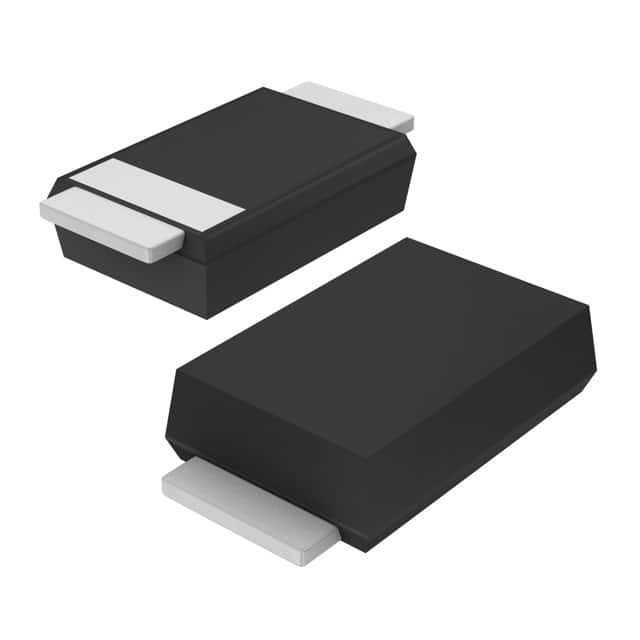Viz Specifikace pro podrobnosti o produktu.

PDZVTR5.6A
Introduction
The PDZVTR5.6A is a specialized electronic component that belongs to the category of voltage reference diodes. This entry provides an overview of the basic information, specifications, detailed pin configuration, functional features, advantages and disadvantages, working principles, detailed application field plans, and alternative models of the PDZVTR5.6A.
Basic Information Overview
- Category: Voltage Reference Diode
- Use: The PDZVTR5.6A is primarily used as a precision voltage reference in various electronic circuits and systems.
- Characteristics: It exhibits high precision and stability in providing a fixed voltage reference, making it suitable for applications requiring accurate voltage regulation.
- Package: The PDZVTR5.6A is typically available in a small surface-mount package, allowing for easy integration into electronic designs.
- Essence: Its essence lies in providing a stable and precise voltage reference for use in analog and digital circuits.
- Packaging/Quantity: It is commonly supplied in reels or tubes containing a specific quantity per package, depending on the manufacturer's specifications.
Specifications
The PDZVTR5.6A is designed with the following specifications: - Voltage Reference: 5.6V - Tolerance: ±5% - Power Dissipation: 250mW - Operating Temperature Range: -55°C to +150°C - Storage Temperature Range: -65°C to +175°C
Detailed Pin Configuration
The PDZVTR5.6A typically features a standard pin configuration with clear markings for easy identification of its terminals. The pinout configuration includes the anode, cathode, and any additional terminals for specific applications.
Functional Features
- Precision Voltage Reference: Provides a stable and accurate 5.6V reference voltage for use in various electronic circuits.
- Low Temperature Coefficient: Ensures minimal voltage variation with changes in temperature, enhancing its suitability for temperature-sensitive applications.
- Low Power Consumption: Contributes to energy-efficient operation in electronic systems where power conservation is essential.
Advantages and Disadvantages
Advantages
- High precision and stability
- Low temperature coefficient
- Small form factor for space-constrained designs
- Low power consumption
Disadvantages
- Limited voltage options (fixed at 5.6V)
- Sensitivity to reverse voltage and current limitations
Working Principles
The PDZVTR5.6A operates based on the principle of Zener breakdown, where it maintains a constant voltage drop across its terminals, ensuring a stable reference voltage output. This allows it to regulate the voltage in electronic circuits and provide a reliable reference point for analog and digital components.
Detailed Application Field Plans
The PDZVTR5.6A finds extensive application in various electronic systems, including but not limited to: - Voltage regulators - Precision analog circuits - Sensor interfaces - Data acquisition systems - Battery management systems
Detailed and Complete Alternative Models
Several alternative models to the PDZVTR5.6A exist in the market, offering different voltage reference values and specifications. Some notable alternatives include: - PDZVTR3.3A (3.3V reference voltage) - PDZVTR7.5A (7.5V reference voltage) - PDZVTR10A (10V reference voltage)
In conclusion, the PDZVTR5.6A serves as a crucial component in electronic design, providing a stable and precise voltage reference for a wide range of applications. Its high precision, low temperature coefficient, and compact form factor make it a preferred choice for engineers and designers seeking reliable voltage regulation solutions.
Word Count: 511
Seznam 10 běžných otázek a odpovědí souvisejících s aplikací PDZVTR5.6A v technických řešeních
What is PDZVTR5.6A?
- PDZVTR5.6A is a high-performance voltage regulator designed for use in various technical solutions to provide stable and reliable power supply.
What are the key features of PDZVTR5.6A?
- PDZVTR5.6A features include high efficiency, low dropout voltage, overcurrent protection, thermal shutdown, and adjustable output voltage.
In what technical solutions can PDZVTR5.6A be used?
- PDZVTR5.6A can be used in applications such as embedded systems, IoT devices, power management modules, battery-powered devices, and industrial automation equipment.
What is the input voltage range for PDZVTR5.6A?
- The input voltage range for PDZVTR5.6A is typically between 2.5V and 18V, making it suitable for a wide range of power supply scenarios.
How does PDZVTR5.6A handle overcurrent conditions?
- PDZVTR5.6A incorporates overcurrent protection, which automatically limits the output current to prevent damage to the device or the connected load.
Can PDZVTR5.6A be used in automotive applications?
- Yes, PDZVTR5.6A is designed to meet the requirements for automotive electronics and can be used in automotive power management systems.
What is the typical output voltage range for PDZVTR5.6A?
- The typical output voltage range for PDZVTR5.6A is adjustable from 0.8V to 5.5V, providing flexibility for different system requirements.
Does PDZVTR5.6A require external components for operation?
- PDZVTR5.6A requires minimal external components for operation, simplifying the design and reducing overall system cost.
Is PDZVTR5.6A suitable for battery-powered devices?
- Yes, PDZVTR5.6A's low dropout voltage and high efficiency make it well-suited for battery-powered devices, extending battery life and improving overall performance.
What are the thermal considerations for using PDZVTR5.6A?
- PDZVTR5.6A includes thermal shutdown protection, which safeguards the device from overheating and ensures reliable operation even in demanding thermal environments.

